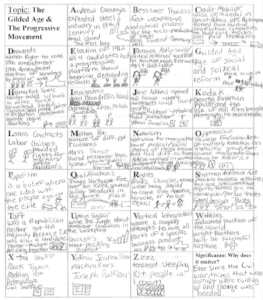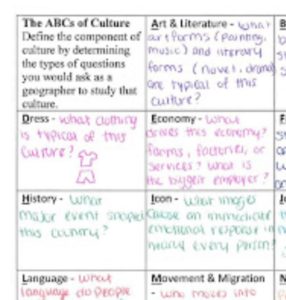Vocabulary Instructional Commitment
Use a Core Set of Strategies: Alphablocks
Once critical vocabulary has been identified for each unit of study, it is much easier to match a strategy to the learning goal. Whether you develop a short or long list of words, you will need to decide how students will come to know, keep track of, and interact with the terms. You will also want to consider how you will assess students’ understanding of the terms and their application to the content. Some strategies can serve multiple purposes and act as touchstones throughout a unit; they may serve as a tool for instruction as well as assessment. Exposure to a variety of vocabulary learning tools also helps students become independent learners, giving students a variety of choices in the way they approach vocabulary learning in other courses in the future.
One vocabulary strategy useful for social studies classrooms is Alphablocks. This tool helps students track their own thinking and organize vocabulary. The blocks are meant to capture words or phrases associated with a theme within a discipline. Concepts should be extensive enough to generate many ideas. For example, in the discipline of U.S. History, a limiting topic would be Upton Sinclair, but a broader topic would be The Gilded Age and Progressive Movement (see image to the left). Within this topic, students might list Andrew Carnegie, Bessemer process, Credit Mobilier, Demand for Women’s Rights, Election of 1912 , Florence Kelley, and so on. Students may also decide to use visual language for the purpose of capturing meaning. A student may sketch laborers striking in the “L” box. Sketching provides students an opportunity to make meaning in their own words. The image serves as a reminder to the word’s meaning and cues the note taker. Asking students to go beyond listing the relevant words, but instead putting their own words in each box that speak to the meaning or significance of the selected topic or concept allows the teacher to use Alphablocks as a formative assessment, showing the teacher what the student knows and where the learning gaps may be. This tool is also one that students may revisit throughout the unit to add evidence of new learning. This strategy takes into consideration that every student approaches a unit with different background knowledge and a personal style of note taking.
, Florence Kelley, and so on. Students may also decide to use visual language for the purpose of capturing meaning. A student may sketch laborers striking in the “L” box. Sketching provides students an opportunity to make meaning in their own words. The image serves as a reminder to the word’s meaning and cues the note taker. Asking students to go beyond listing the relevant words, but instead putting their own words in each box that speak to the meaning or significance of the selected topic or concept allows the teacher to use Alphablocks as a formative assessment, showing the teacher what the student knows and where the learning gaps may be. This tool is also one that students may revisit throughout the unit to add evidence of new learning. This strategy takes into consideration that every student approaches a unit with different background knowledge and a personal style of note taking.
Quick Adaptation
In teaching students a unit on culture in a geography course, the teacher wanted to focus students on the enduring understanding that “all cultures have common traits, but how they exhibit those traits might look differently.” The students had also been working on the skill of “thinking like a geographer”. The teacher adapted the Alphablocks so that instead of defining the traits of culture (e.g. government, language or taboos), the students had to ask questions that showed their understanding of the trait as well as their ability to think like a geographer. See example to the right:
might look differently.” The students had also been working on the skill of “thinking like a geographer”. The teacher adapted the Alphablocks so that instead of defining the traits of culture (e.g. government, language or taboos), the students had to ask questions that showed their understanding of the trait as well as their ability to think like a geographer. See example to the right:
If you’re eager to try this vocabulary strategy out with your students, here is a free template for you: Alphablocks Template
Check out our next blog, where we dive into the Frayer Model!
